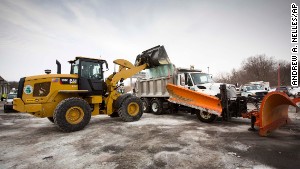Editor's note: David Frum is a contributing editor at Newsweek and The Daily Beast and a CNN contributor. He is the author of seven books, including a new novel, "Patriots." This column is adapted from one that appeared in July 2012.
(CNN) -- Congratulations: If you're reading this, there's a good chance you still have electricity. Unfortunately, tens of thousands of Americans hit by winter weather in the South this week couldn't join you. And ice and storms making their way north threaten loss of power stretching to Vermont.
Why do Americans tolerate such outages?
They are not inevitable. The German power grid has outages at an average rate of 21 minutes per year.
 David Frum
David Frum The winds may howl. The trees may fall. But in Germany, the lights stay on.
There's no Teutonic engineering magic to this impressive record. It's achieved by a very simple decision: Germany buries almost all of its low-voltage and medium-voltage power lines, the lines that serve individual homes and apartments. Americans could do the same. They have chosen not to.
Electric users ask: Why not put power lines underground?
The choice has been made for reasons of cost. The industry rule of thumb is that it costs about 10 times as much to bury wire as to string wire overhead: up to $1 million per mile, industry representatives claim. Since American cities are much less dense than European ones, there would be a lot more wire to string to serve a U.S. population than a European one.
Cost matters.
But now reflect:
 Atlantans stocks up for winter storm
Atlantans stocks up for winter storm  Forecast: Crippling, catastrophic ice
Forecast: Crippling, catastrophic ice  Atlanta ready for second ice blast?
Atlanta ready for second ice blast? 1. There's reason to think that industry estimates of the cost of burying wires are inflated. While the U.S. industry guesstimates costs, a large-scale study of the problem conducted recently in the United Kingdom estimated the cost premium at 4.5 to 5.5 times the cost of overhead wire, not 10 times.
2. U.S. cost figures are a moving target. American cities are becoming denser as the baby boomers age and opt for central-city living. Denser cities require fewer miles of wire to serve their populations.
3. Costs can only be understood in relation to benefits. As the climate warms, storms and power outages are becoming more common. And as the population ages, power failures become more dangerous. In France, where air conditioning is uncommon, a 2003 heat wave left 10,000 people dead, almost all of them elderly. If burying power lines prevented power outages during the hotter summers --and icier winters -- ahead, the decision could save many lives.
4. As you may have heard, many Americans remain unemployed. Joblessness is acute among less educated workers, many of whom used to work in the depressed construction industry. Burying power lines is a project that could put many hundreds of thousands of the unemployed to work at tasks that make use of their skills and experience.
The Obama stimulus failed to produce many projects of lasting benefit to the country. Yet even now, borrowing costs remain low for governments and large ultilities. Burying power lines is a public works project for the 21st century that our children and grandchildren would appreciate -- and that might save our parents' lives.
Follow @CNNOpinion on Twitter.
Join us at Facebook/CNNOpinion.
{ 0 comments... read them below or add one }
Post a Comment